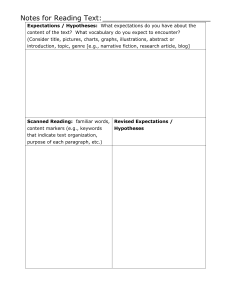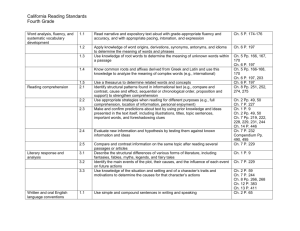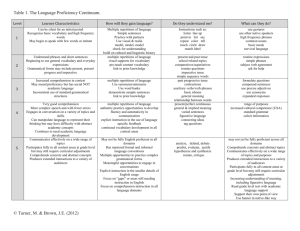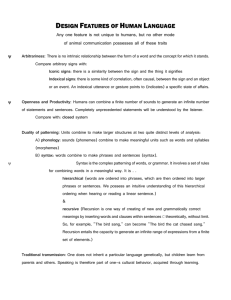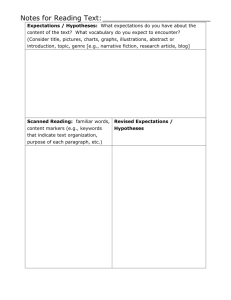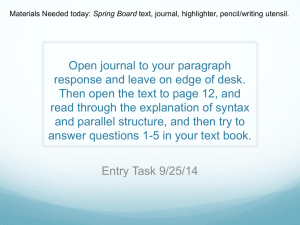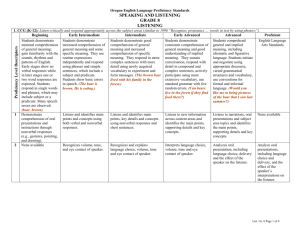speaking and listening
advertisement
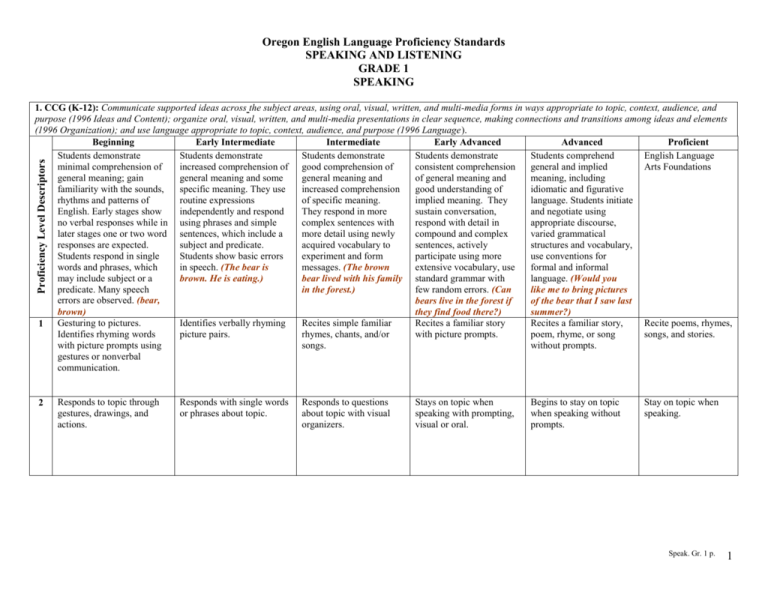
Oregon English Language Proficiency Standards SPEAKING AND LISTENING GRADE 1 SPEAKING Proficiency Level Descriptors 1. CCG (K-12): Communicate supported ideas across the subject areas, using oral, visual, written, and multi-media forms in ways appropriate to topic, context, audience, and purpose (1996 Ideas and Content); organize oral, visual, written, and multi-media presentations in clear sequence, making connections and transitions among ideas and elements (1996 Organization); and use language appropriate to topic, context, audience, and purpose (1996 Language). Beginning Early Intermediate Intermediate Early Advanced Advanced Proficient Students demonstrate Students demonstrate Students demonstrate Students demonstrate Students comprehend English Language minimal comprehension of increased comprehension of good comprehension of consistent comprehension general and implied Arts Foundations general meaning; gain general meaning and some general meaning and of general meaning and meaning, including familiarity with the sounds, specific meaning. They use increased comprehension good understanding of idiomatic and figurative rhythms and patterns of routine expressions of specific meaning. implied meaning. They language. Students initiate English. Early stages show independently and respond They respond in more sustain conversation, and negotiate using no verbal responses while in using phrases and simple complex sentences with respond with detail in appropriate discourse, later stages one or two word sentences, which include a more detail using newly compound and complex varied grammatical responses are expected. subject and predicate. acquired vocabulary to sentences, actively structures and vocabulary, Students respond in single Students show basic errors experiment and form participate using more use conventions for words and phrases, which in speech. (The bear is messages. (The brown extensive vocabulary, use formal and informal may include subject or a language. (Would you brown. He is eating.) bear lived with his family standard grammar with predicate. Many speech few random errors. (Can in the forest.) like me to bring pictures errors are observed. (bear, bears live in the forest if of the bear that I saw last brown) they find food there?) summer?) Identifies verbally rhyming Recites simple familiar Recites a familiar story Recites a familiar story, Recite poems, rhymes, 1 Gesturing to pictures. Identifies rhyming words picture pairs. rhymes, chants, and/or with picture prompts. poem, rhyme, or song songs, and stories. with picture prompts using songs. without prompts. gestures or nonverbal communication. 2 Responds to topic through gestures, drawings, and actions. Responds with single words or phrases about topic. Responds to questions about topic with visual organizers. Stays on topic when speaking with prompting, visual or oral. Begins to stay on topic when speaking without prompts. Stay on topic when speaking. Speak. Gr. 1 p. 1 Oregon English Language Proficiency Standards SPEAKING AND LISTENING GRADE 1 SPEAKING (cont.) Beginning Identifies who, what, where questions about familiar stories, using nonverbal response. Early Intermediate Responds with single words or phrases about story. Intermediate Responds with short phrases or sentences using visual organizers to sequence story. Early Advanced Retells familiar story using questions, visual or gestures by answering who, what, when, where, why, and how. Advanced Retells stories using basic story grammar and relating the sequence of story events by answering who, what, when, why, and how questions. 4 None Available. Demonstrates an important life event or personal experience using gestures, drawings, or actions. Responds with single words or phrases about an important life event or personal experience. Responds to questions about personal life experiences by using short phrases or sentences. Responds to questions about life experiences using more complex phrases and sentences. 5 Acts out descriptive words for people, places, things, and events with teacher support. Uses simple descriptive words to describe common or familiar people, places, things, and events, with teacher support and visual organizers. Responds to questions about people, places, things, and events using short descriptive phrases or sentences using visual organizers, with teacher support. Uses more complex phrases and sentences to describe people, places, things, and events, with teacher support. Begins to use descriptive words when speaking about people, places, things, and events, with teacher support and prompting. 3 Proficient Retell stories using basic story grammar and relating the sequence of story events by answering who, what, when, where, why, and how questions. Relate an important life event or personal experience in a simple sequence. With guidance, use descriptive words when speaking about people, places, things, and events. Speak. Gr. 1 p. 2 Oregon English Language Proficiency Standards SPEAKING AND LISTENING GRADE 1 SPEAKING Proficiency Level Descriptors 2. CCG (K-12): Demonstrate control of eye contact, speaking rate, volume, enunciation, inflection, gestures, and other nonverbal techniques (1996 Delivery). TESOL: 1 and 2 Beginning Early Intermediate Intermediate Early Advanced Advanced Proficient Students demonstrate Students demonstrate Students demonstrate Students demonstrate Students comprehend English Language minimal comprehension of increased comprehension good comprehension of consistent comprehension of general and implied Arts Foundations general meaning; gain of general meaning and general meaning and general meaning and good meaning, including familiarity with the sounds, some specific meaning. increased comprehension understanding of implied idiomatic and figurative rhythms and patterns of They use routine of specific meaning. meaning. They sustain language. Students initiate English. Early stages show expressions independently They respond in more conversation, respond with and negotiate using no verbal responses while in and respond using phrases complex sentences with detail in compound and appropriate discourse, later stages one or two word and simple sentences, more detail using newly complex sentences, actively varied grammatical responses are expected. which include a subject acquired vocabulary to participate using more structures and vocabulary, Students respond in single and predicate. Students experiment and form extensive vocabulary, use use conventions for words and phrases, which show basic errors in messages. (The brown standard grammar with few formal and informal may include subject or a speech. (The bear is language. (Would you bear lived with his family random errors. (Can bears predicate. Many speech brown. He is eating.) in the forest.) live in the forest if they find like me to bring pictures errors are observed. (bear, food there?) of the bear that I saw last brown) summer?) Makes oneself understood Makes oneself understood Makes oneself understood Demonstrates an Speak clearly. 1 Speaks a few words or sentences by using some when speaking, but may when speaking by using when speaking by using understanding of English phonemes and have some inconsistent consistent standard consistent standard English idiomatic expressions rudimentary English use of standard English English grammatical grammatical forms, sounds, (e.g., “Give me a hand”) grammatical forms (e.g., grammatical forms and forms and sounds; intonation, pitch, and by responding to such single words or phrases). sounds (e.g., plurals, however, some rules may modulation, but may make expressions and using simple past tense, not be followed (e.g., random errors. them appropriately. pronouns such as he or third-person singular, she). male and female pronouns). Looks at listeners. Looks at listeners. Looks at listeners. Looks at listeners. Look at listeners. 2 Looks at listeners. Speak. Gr. 1 p. 3
